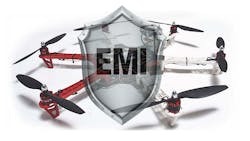EMI Shielding for Drones and UAVs (Download)
Most drones and unmanned aerial vehicles (UAVs) rely heavily on seamless communication from ground systems. Cell-phone towers, buildings and large metal structures, high-voltage power lines, and a high concentration of Wi-Fi networks in an area can cause serious electromagnetic interference (EMI) in drone performance.
EMI effects on drone operations are unpredictable. They can severely disrupt a drone’s navigation system by shifting the drone’s compass out of alignment. When flying close to large structures, EMI can degrade the quality of GPS reception of a drone. It also may disrupt the communication between a drone and its controller.
There’s a growing trend toward drones/UAVs being used to inspect utility areas such as electrical power grids and pipelines. Infrastructure like cell towers also need visual inspection. This is far less costly than a “truck roll” to a site.
